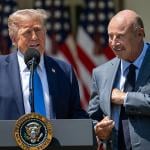
A Child, A Daisy, and the Birth of Political Mud-Slinging
It seems there has always been negativity attached to American Presidential elections. People disagree, sometimes vehemently, with the other party’s candidate. Maybe an attack on one’s opponent is considered “good politics.” To me, “good politics” is an oxymoron, and political ads are definitely the worst of the worst part of contemporary election tactics. Where did it all come from, I wonder. I remember a child, a daisy, and the subtle birth of political mud-slinging.
1964
The first election I really remember was 1964: Barry Goldwater and Lyndon Johnson. Not that long since the assassination of JFK, with a war in a previously unheard-of place called Vietnam, the fear of nuclear weapons, the Cold War, and racial tensions running high, ’64 was arguably as uncomfortable an election as the one we face today, 60 years later.
In 1964, it was commonly believed that the United States and Soviet Union already had over 30,000 nuclear weapons. Out of fear of imminent attack, fallout shelters were built in peoples’ backyards and in the basements of some public buildings. Rumors of bombs being tested in secret, underground locations flew. I personally remember “duck and cover” drills at school where we frightened students would curl up under desks away from windows in case of attack–ridiculous–almost humorous.
Jesse Greenspan for History.com paints the political scene:
“[Lyndon] Johnson, who had become president the previous year following the John F. Kennedy assassination … relentlessly portrayed [Barry] Goldwater as an unstable extremist, not just for his nuclear positions but also for opposing the Civil Rights Act and for stating that Social Security ought to be voluntary. In private, Johnson called Goldwater ‘nutty as a fruitcake.’ At the same time, Johnson saw himself as ‘the source of order and calm and composure’ who would ‘keep everyone safe.’
“Goldwater … called the atomic bomb ‘merely another weapon,’ suggested using ‘low-yield’ nuclear arms to defoliate forests and disrupt enemy supply lines in Vietnam, and joked about lobbing a nuclear missile into the men’s room of the Kremlin.
“In addition, Goldwater opposed both nuclear disarmament and limitations to nuclear weapons testing. He thought the use of nuclear weapons shouldn’t always require presidential approval, and he mocked those who ‘would rather crawl on [their] knees to Moscow than die under an atom bomb.'”
Although Johnson was nearly assured of winning the election, he chose to play on the fears and emotions of the American people. He used a child and a daisy, and subtly gave birth to political mud-slinging.
According to Jesse Greenspan in his article “The 1964 Campaign that Leveraged Cold War Fears” (May 8 2024), it was these attitudes that “ushered in an era of negative political advertising that has yet to abate and cemented the importance of TV to political campaigns … Before then … campaigns generally took a fact-based approach to ads, selling their candidates like they would a bar of soap. Many of Johnson’s ads, on the other hand, were pithy, short spots designed to generate a visceral emotional response.”
A Different Kind of Political Strategy
This environment gave birth to the most terrifying political ad that ever crossed American airwaves. It aired only once on a Monday evening. As an eight-year-old, I was not prepared for the horror of a child, a daisy, and a nuclear bomb. By the reaction of my adult family members, they were not prepared either. It was what many historians believe to be the first of political mud-slinging ads, and even though it never mentioned Goldwater by name, the implication was clear. And Johnson’s calm, assuring voice followed the shock.
https://www.history.com/videos/campaign-spot-peace-little-girl-1964
God bless you and God bless and protect the United States of America.
.













